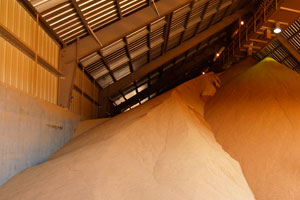High moisture in grain holds greater risk of engulfment

Experts from the US’s Ohio State University’s College of Food, Agricultural, and Environmental Sciences are advising farmers to take safety precautions to prevent grain engulfment, particularly this year when the moisture in grain is high.
Higher moisture levels in some crops could lead to more out-of-condition grain at storage time, which in turn can increase the chance for grain bin disruptions and potential engulfments, said Andrew “Dewey” Mann, safety research associate for Ohio State University Extension. OSU Extension is the outreach arm of the college.
“With cooler conditions over much of the growing season this summer in the region followed by a damp fall, the way things are looking right now we’re hearing from some growers that moisture levels are at 28-32%,” Mann said. “Some growers have started harvesting already, and they have to get that grain harvest down to safe storage moisture levels.
“Corn needs to be at safe storage moisture of about 15%, or cooled quickly to reduce biological activity (spoiling grain).”
This lessens the potential for grain bin engulfments because out-of-condition or spoiled grain can impact the flow of grain in the bin, Mann said. Grain bin engulfments can occur when growers enter the grain bin to determine why grain flow has stopped or slowed, he said.
“Many anecdotal reports and case studies of grain engulfments include farmers who, after finding the flow of grain stopped, will enter the grain bin alone with the auger continuing to run and begin to poke at the lodged grain from above with a long pipe, bar or board,” Mann said. “But when the pipe breaks through the caked grain over the grain intake, grain flows and the farmer is immediately buried in the grain.”
In fact, in 2010, there were 51 grain entrapments on farms and commercial facilities nationwide, half of which were fatal, he said. Already in Ohio, there have been two fatalities this year alone involving grain bins and silos, Mann said.
To that end, members of the college’s agriculture safety team are promoting National Farm Safety week Sept. 15-21 to promote programmes and other resources available to help protect farm families and farm workers from farm-related injuries and deaths.
The week-long communication efforts, Mann said, include daily promotions via social media of the farm-safety related topics. More information on agriculture safety and farm safety week can be found at http://agsafety.osu.edu.
One of those promotions includes a focus on the Grain Community Agricultural Rescue Trailer (C.A.R.T.) – Ohio’s first grain rescue simulator, which was designed by CFAES students and is used to train first responders, grain industry employees and farm families about the hazards of flowing grain. The Grain CART, which is now being used statewide by the Ohio Fire Academy to train first responders, is also being used in rural communities to raise awareness of grain bin engulfment hazards, Mann said.
“Even experienced growers can find themselves engulfed in grain bins and silos,” he said, noting that the two fatalities associated with grain bins and silos this year in Ohio were both males over the age of 65.
“Most growers have probably entered that grain bin many times before but each year is a new product as a result of a new growing season,” Mann said. “Even though you’ve been in that grain bin before doesn’t mean that the conditions are similar to those you’ve encountered before.
“The issue is that when the grain stops flowing, that’s the point where people often stop thinking about safety and focus on the need to get the product out. They just don’t anticipate how quickly the grain will start flowing.”
From 2001-2010, Ohio reported 14 farm-related deaths associated with grain bins and silos, he said.
Some safety tips for growers when working with grain bins and silos include:
- Stay out of the grain bin if possible.
- Never enter a grain bin when the unloading equipment is on even if the grain isn’t flowing.
- Never enter a grain bin alone. If entry into the bin is necessary, always have an observer outside the bin, and make sure all augers are turned off. One person is to enter the bin and the other(s) remain outside in case an emergency occurs. Always use a body harness with a lifeline secured to the outside of the bin.
- Don’t enter a bin that has automatic unloading equipment without first locking out power to the equipment.
- Be cautious around out-of-condition grain, including grain caked to walls. Dangers result from molds, blocked flow, cavities, rusting and grain avalanches.
- Lock doors, gates and discharge chutes of any grain storage units.
- Keep kids out of grain wagons, carts and semi beds.
- Block ladders and egress points (for example a ladder guard) to limit kids’ access.
Source: OSU











